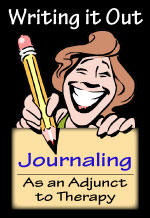Even the well-seasoned therapist can feel “stuck” with a client who’s overwhelmed, blocked, or shut down. Suggesting expressive writing or drawing (“journaling”), either during or between sessions, can help get the process back on track. Both freewriting (writing whatever comes to mind) and guided journaling (starting with a specific prompt) are beneficial.
Journaling can help to:
- Engage a therapy-shy or reticent client (especially teen-effective!).
- Reduce overwhelm by changing abstract thoughts and feelings into concrete words on paper.
- Bypass defenses and uncover new information.
- Organize thoughts and feelings to facilitate clear thinking and better decision-making.
- Increase self-awareness.
- Release affect in a safe manner.
- Teach, strengthen, or practice a coping skill.
A supply of paper, pens, and crayons can be kept at hand. At appropriate times, the clinician might patiently suggest:
- “Instead of talking more, want to try something a little different?”
- “There’s so much inside you – how about letting it out on paper?” (Let them write whatever they need until they feel relief.)
- “Maybe there’s too much to manage at once. Try listing the 5 main things you’re thinking (or feeling) right now.”
- “That feeling seems overwhelming. How about showing what it might look like in physical form? Use colors, lines, or whatever you need.”
- “I wonder why this comes up so often. How about drawing a pie chart showing what makes up your self-esteem?”
- “Between sessions, try writing in your journal just as if you’re talking to me.”
- “Try practicing your positive thinking by writing a gratitude list each night before bed.”
- “Instead of self-harm, try putting your pain into words or pictures.”
When reviewing clients’ expressions, instead of interpreting, ask:
- What was it like for you to do this?
- What’s the most important part of this for you?
- What do you notice when you look this over?
Related Online Continuing Education (CE) Courses:
Writing it Out: Journaling as an Adjunct to Therapy is a 2-hour online continuing education (CE) course that discusses why and how to use journal writing as a therapeutic tool.
Journaling II: Directed Exercises in Journaling is a 4-hour online continuing education (CE) course that provides the foundation for journal-writing techniques, including exercises you can use with clients.
Lisa M. Schab, L.C.S.W. is a psychotherapist with a private counseling practice in the Great Chicago, IL area. She has authored seventeen books, including The Anxiety Workbook for Teens and Put Your Worries Here: A Creative Journal for Teens with Anxiety – the first in a new series of creative, engaging guided journals addressing specific teen issues. She teaches self-help workshops and professional training courses on both anxiety and journaling and is a member of the National Association of Social Workers (NASW). To learn more about the use of journaling and guided journals as an adjunct to therapy, visit www.lisamschabooks.com. To earn continuing education credits on these topics, find Lisa’s professional training courses at https://www.pdresources.org/.




